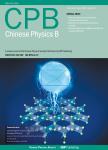Stacking-dependent exchange bias in two-dimensional ferromagnetic/antiferromagnetic bilayers
Stacking-dependent exchange bias in two-dimensional ferromagnetic/antiferromagnetic bilayers作者机构:International Center for Quantum Design of Functional MaterialsHefei National Research Center for Physical Sciences at the MicroscaleUniversity of Science and Technology of ChinaHefei 230026China Department of PhysicsUniversity of Science and Technology of ChinaHefei 230026China Department of PhysicsSouthern University of Science and TechnologyShenzhen 518055China Department of Materials Science&EngineeringUniversity of Science and Technology of ChinaHefei 230026China
出 版 物:《Chinese Physics B》 (中国物理B(英文版))
年 卷 期:2024年第33卷第1期
页 面:708-714页
核心收录:
学科分类:07[理学] 070205[理学-凝聚态物理] 0702[理学-物理学]
基 金:Project supported by the National Key Research and Development Program of China (Grant No.2019YFA0210004) the Strategic Priority Research Program of Chinese Academy of Sciences (Grant No.XDB30000000) the Fundamental Research Funds for the Central Universities (Grant No.WK3510000013) the National Supercomputing Center in Tianjin。
主 题:exchange bias two-dimensional ferromagnetic/antiferromagnetic bilayers asymmetric magnetic interaction
摘 要:A clear microscopic understanding of exchange bias is crucial for its application in magnetic recording, and further progress in this area is desired. Based on the results of our first-principles calculations and Monte Carlo simulations,we present a theoretical proposal for a stacking-dependent exchange bias in two-dimensional compensated van der Waals ferromagnetic/antiferromagnetic bilayer heterostructures. The exchange bias effect emerges in stacking registries that accommodate inhomogeneous interlayer magnetic interactions between the ferromagnetic layer and different spin sublattices of the antiferromagnetic layer. Moreover, the on/off switching and polarity reversal of the exchange bias can be achieved by interlayer sliding, and the strength can be modulated using an external electric field. Our findings push the limits of exchange bias systems to extreme bilayer thickness in two-dimensional van der Waals heterostructures, potentially stimulating new experimental investigations and applications.



